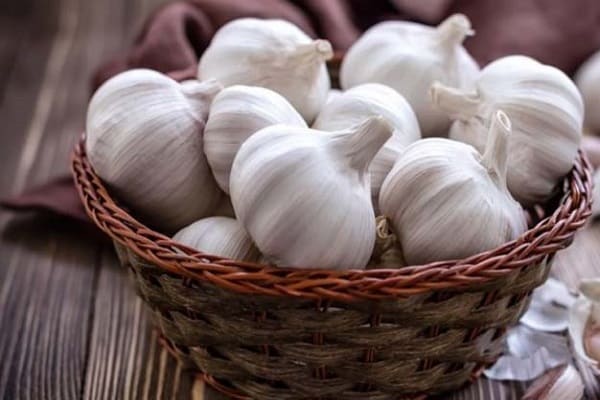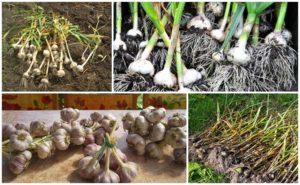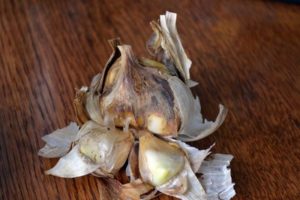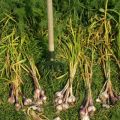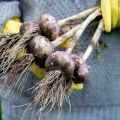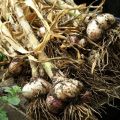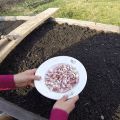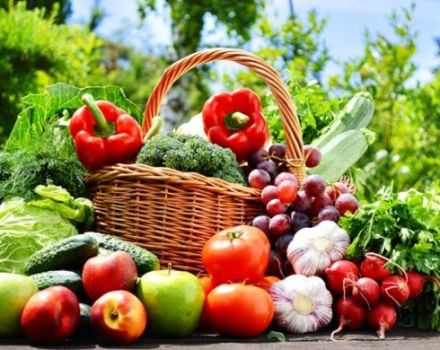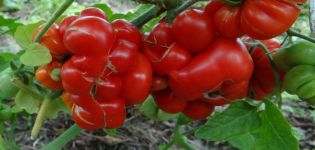When do you need to remove spring garlic from the garden for storage?
Garlic planted in spring has advantages over autumn planting in that it does not dry out and has a long shelf life. But in order for it to finally mature, have nutrients, it is necessary to observe the timing of its cultivation and, most importantly, to know when to harvest spring garlic.
Signs of readiness to clean
Harvesting a crop planted in autumn is different from that of a spring crop. The winter plant forms roots after planting in the fall, and as soon as the ground warms up in spring, it immediately begins to grow. Spring garlic takes time to take root, so spring garlic is harvested much later. Usually the time to harvest summer garlic is mid-August or early September.
Much depends on the weather in summer, and experienced gardeners also pay attention to rainfall. Favorable conditions for accelerating growth spring garlic frequent rains are considered. When the summer is dry, the crop head develops more slowly.
If you dig up summer garlic from the garden before the set harvest time, then it will not be possible to store it for a long time. True, many gardeners dig it out a little earlier, so that it matures during drying. It is believed that it is better not to ripen than its cloves begin to crumble by themselves and begin to grow again. It will be impossible to save such a crop. Opened on its own, without the presence of scales, dries very quickly.
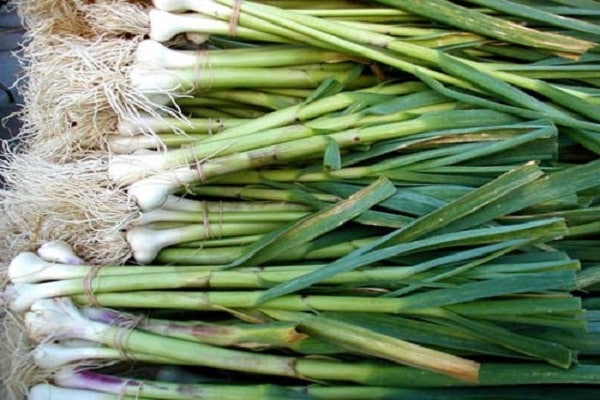
How do you know about maturation?
Before digging or pulling a crop out of the ground, you will need to constantly monitor it.
There are several signs by which we know when to dig up spring garlic:
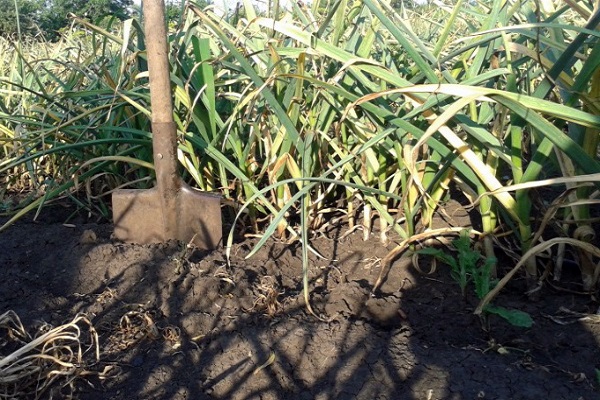
- The tops of the ripening spice should turn almost completely yellow and lie slightly on the ground.
- Before digging, you need to consider the root collar: it usually dries out.
- The dug out bulbs should be fully formed, and the cloves should stand out brightly through the scales and fit snugly against each other. They are very easy to separate with your hands, without any tools.
- The bulb is covered with a dense skin of about 3 layers. It is easy to remove it with your hands.
- The spice has a characteristic color for the variety: purple, white.
Unfortunately, the spice in the beds does not ripen at the same time. The time changes every year, so you need to be observant, try to determine by signs that it is ripe, and it's time to harvest the garlic.
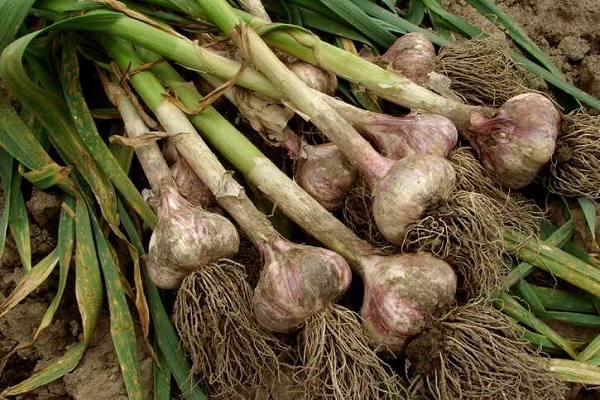
Do not forget that in August, long rains begin, which affect the quality of products, so the harvesting of spring garlic should be done quickly and on time.
Harvesting rules
Choose a dry, sunny day for digging. It is advisable that the soil is not wet.
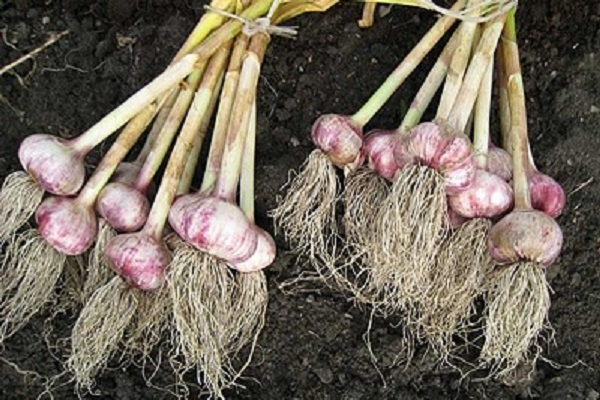
And in order to collect a spice of good yield, you should know how and when to dig spring garlic:
- If during harvesting, when inspecting the tops, it was noticed that most of it turned yellow, it is recommended to partially remove the soil from the bulbs so that it is easier to harvest them later.
- Watering should be stopped about a week before harvesting. The earth should dry out well.
- Cleaning is desirable in the morning or evening hours of the day, choosing a dry day.
- You can use a pitchfork or a shovel to harvest spring garlic. It is buried in a few centimeters from the head so as not to damage it.
- If I plant the garlic close to the surface of the earth and it is loose, then you can dig in the ground a little, and then pull the heads, grabbing the tops. If it comes off accidentally, which is undesirable, carefully pull the head out of the soil with your hands so as not to accidentally damage it.

Collected garlic should not be hit against each other, much less thrown. It is neatly placed on dry ground or in baskets. For quick drying, it is recommended to spread thick paper or burlap on the bed.
After drying a little, it is advisable to immediately clear the bulbs of the earth and upper scales. In this case, you should inspect the crop and carry out sorting. It is recommended to store damaged bulbs separately as they cannot be stored. Having collected the largest specimens, they are set aside for sowing next year.
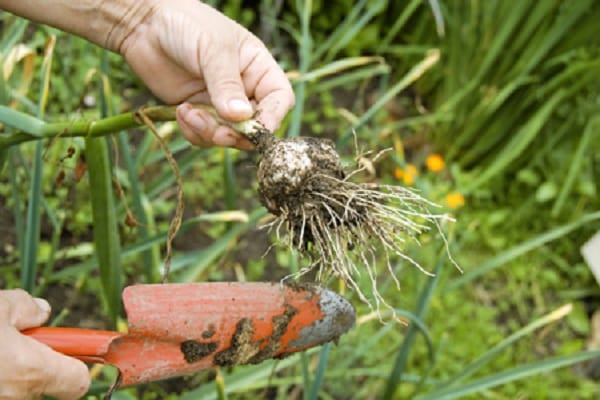
It is advisable not to separate the tops immediately so that the garlic ripens. It should be stored in this way for about a week. In sunny dry weather, take it outside, laying out in rows on burlap. But, so that there are no burns, the garlic is lightly covered with dry leaves or hay. If the weather changes, then it is better to remove the garlic under a canopy so that it is well ventilated. After ripening, the stem and leaves are cut off, leaving a tail about 3-4 cm. The root is partially shortened with scissors or a knife, leaving about 4 mm, it is not removed completely.
Storage preparation
Well dried garlic is ready for storage. For these purposes, you need to choose a cool place, the humidity of which should not exceed 80%. If it is too dry, then the garlic will begin to shrivel and wither, and with high humidity it will germinate, in the worst case, it will rot.
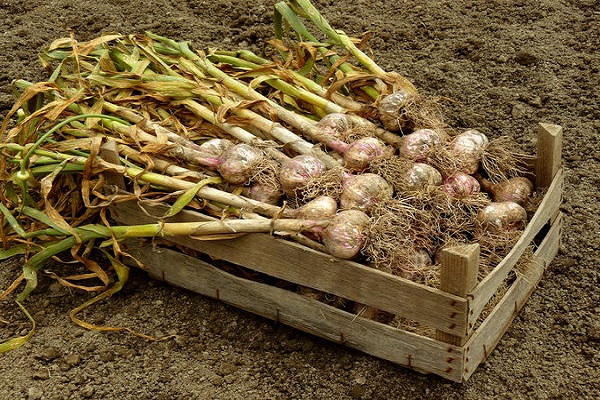
Cleaning and storage are simple: it can be put in a box not with a thick layer, stored at room temperature, only away from heating radiators.
If it was not possible to dry the bulbs well, before collecting them for storage, it is recommended to carry out processing in order to increase keeping quality. To do this, you first need to scorch the roots on fire. Then prepare a special composition for which you will need sunflower oil, iodine and water.
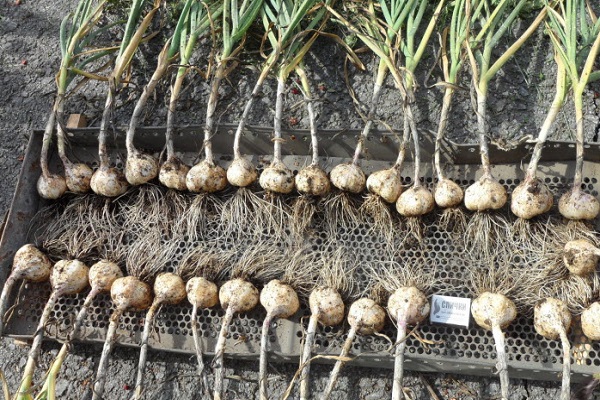
It is recommended to boil the oil in a water bath for about 10 minutes, then cool. Take 0.5 liters of boiled water. Pour the cooked oil into it, drop about 10 drops of iodine, mix everything thoroughly. It is recommended to dip each onion in turn in this composition, then lay them out on thick paper, dry and put in storage.
Storage methods
In order to extend the storage time of spring planting, there are many ways.
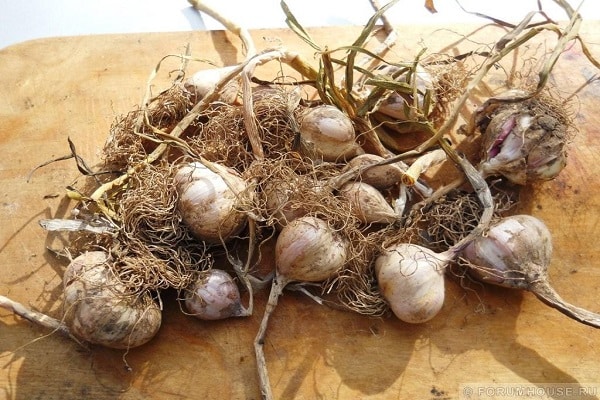
How was it kept in the old days?
Let's take a closer look at how to store garlic, based on the experience of our ancestors:
- For storage, boiled vegetable oil was used. The teeth were neatly torn off or the heads were placed entirely in some container. They put them in a dark place. The oil acquired a pleasant spice taste and garlic aroma, and it was used in salads.
- The well-dried heads were sprinkled with flour. To do this, they took a box, laid out the heads of garlic in rows, and sprinkled each one with flour, covered it with a lid on top. The flour absorbed excess moisture well, and the garlic did not spoil until spring.
- The ash powder kept the garlic bulbs even longer. He could be at room temperature.
- Table salt is also considered an excellent remedy: it perfectly disinfects and absorbs excess moisture.
- Our grandmothers used canvas bags for storage. First, a concentrated solution of table salt was diluted, bags were dipped into it, then they were dried, and garlic was put in them. It was well protected from excess moisture and did not rot.

Some people liked to decorate the kitchen with garlic braids. To do this, its dried leaves were woven into twine, or if there was no time for weaving, the garlic was laid in nylon stockings and hung. But such a crop often had to be sorted out, since there was high humidity in the kitchen. You can put the spice in boxes or baskets, then there will be free access to air. Onion peels can be used for storage, they are sprinkled with onions, but it is recommended to take care of the garlic, raising it higher.
Stores well in dry sawdust. It is placed in a box or box, each layer is sprinkled with sawdust.
Modern storage methods
Over the years, new materials and technologies have appeared on how to store spring garlic:
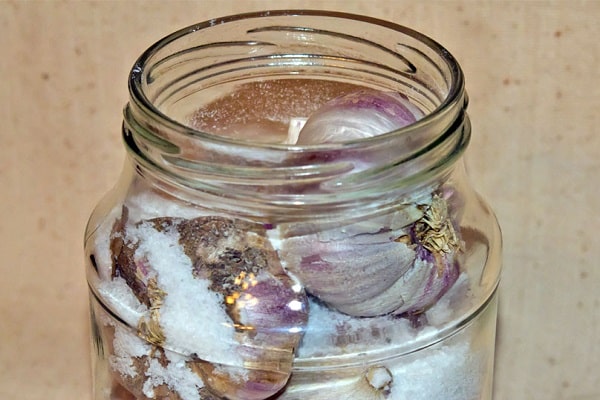
- Bulbs wrapped in plastic wrap are perfectly preserved. Its freshness is preserved, it does not dry out.
- Many people like the use of paraffin wax. If it is not available, then you can buy candles and melt. Dip an onion in them, it will be covered with a protective paraffin film. This garlic keeps well.
Garlic is the most popular spice, the cultivation of which is relevant almost everywhere. Many housewives use it in the preparation of delicious savory dishes and canning. Every gardener in 2018 is interested in its long-term storage, but for this it is not enough just to create optimal conditions, the main thing is to choose the right time when you need to harvest summer garlic.
